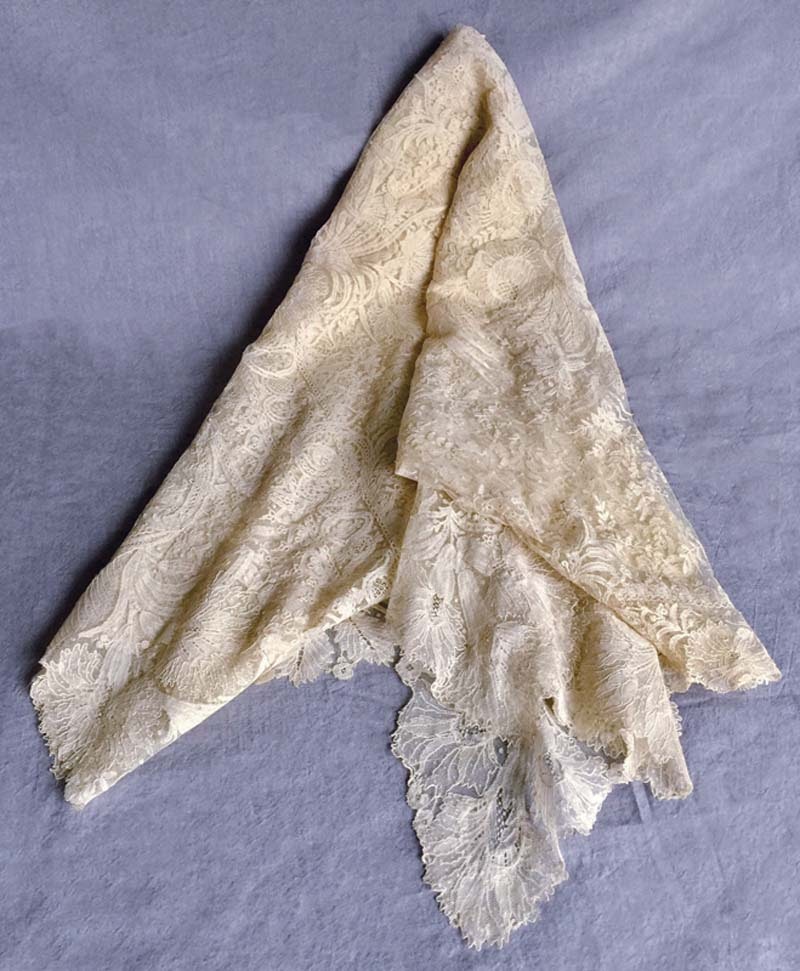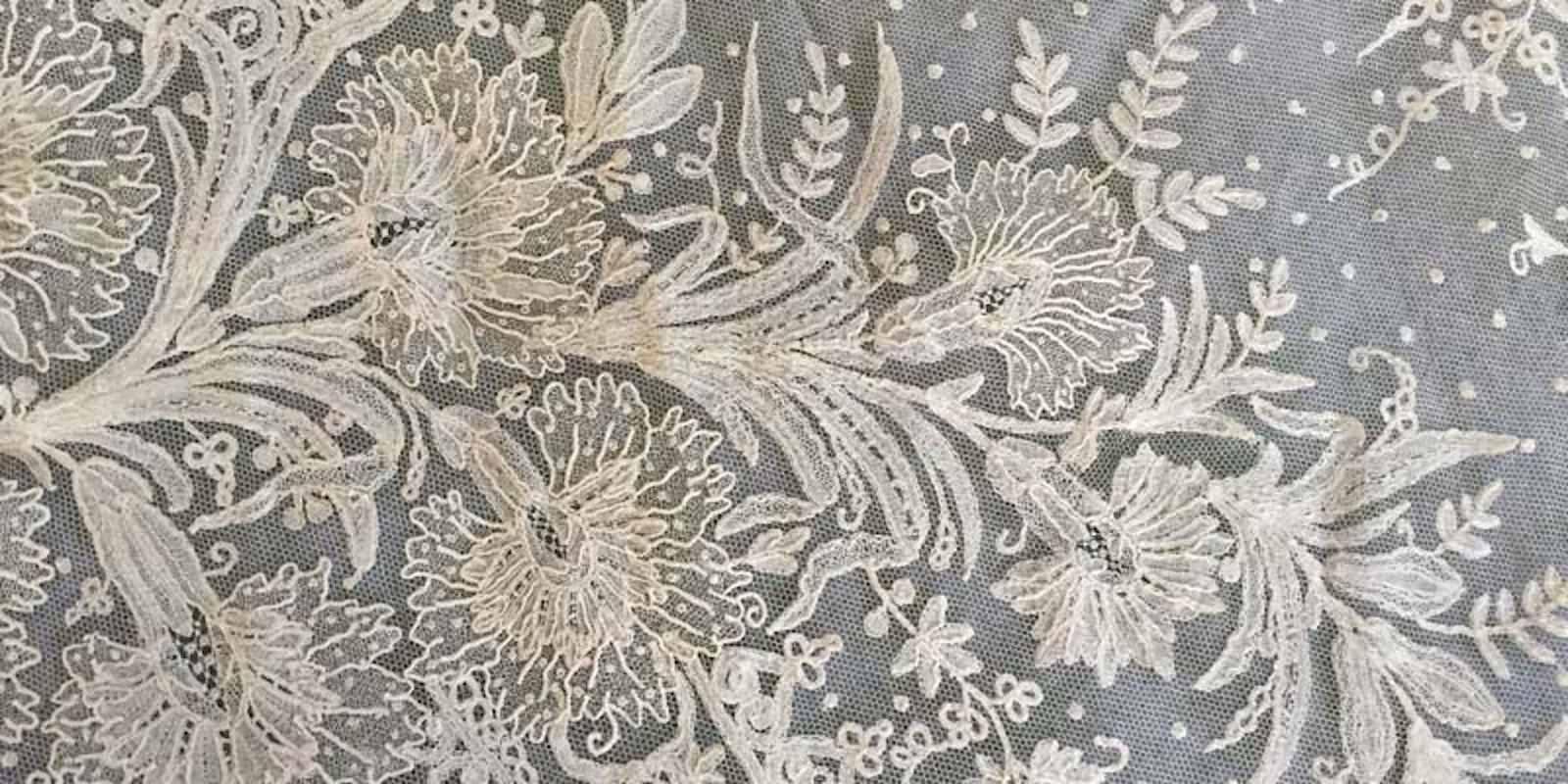Subscriber Exclusive
Threads of Tradition: The Story of the Green Family’s Wedding Veil
By incorporating the tradition of using Mary Elizabeth Mulligan’s veil in wedding celebrations through the generations, the Green family enjoyed and honored the lace and gained some wonderful memories.
By incorporating the tradition of using Mary Elizabeth Mulligan’s veil in wedding celebrations through the generations, the Green family enjoyed and honored the lace and gained some wonderful memories. <a href="https://pieceworkmagazine.com/threads-of-tradition-the-story-of-the-green-familys-wedding-veil/">Continue reading.</a>
https://pieceworkmagazine.com/cdn-cgi/image/format=auto/https://www.datocms-assets.com/75076/1656653516-header_lace_detail-crop.jpeg?auto=format&w=900
More than one hundred and fifty years ago, Mary Elizabeth Mulligan (August 31, 1835–March 8, 1911) unknowingly began a family tradition when she selected a point d’Angleterre lace veil for her wedding on October 1, 1857,
to Robert Stockton Green (March 25, 1831–May 7, 1895). Since then, the veil has been an important accessory for twenty-three more brides in the Green family. Although we have no details about how Mary Elizabeth chose this particular piece of lace, we know that its beauty graced this nineteenth-century bride and began to wend its way through many weddings over the years.
[PAYWALL]
Lacemaking is a skill requiring meticulous attention to detail. During the nineteenth century, it was hand-produced by thousands of talented unnamed women, who toiled for countless hours. Constructed of fine linen threads, Brussels lace also has been referred to as point d’Angleterre. Whether
named so because of the belief that the thread was of English origin or in reference to its ultimate market destination, experts agree that the workmanship of this lace was of exceptional quality.
As a newly betrothed, Mary would have assembled a proper trousseau, consisting first and foremost of her wedding dress and assorted undergarments. She would most likely have subscribed to and consulted the latest issue of Godey’s Lady’s Book, a popular women’s magazine published
from 1830 to 1898. The editor at the time of Mary’s engagement, Sarah Josepha Hale (1788–1879; also the author of “Mary Had a Little Lamb”), reportedly influenced women’s issues of the era by including a regular section titled “Employment for Women.” She also, however, was known to have a keen eye for the latest fashions.
During the 1850s, dress styles had increasingly fuller skirts, requiring up to a dozen starched muslin petticoats to support the volume of fabric used in a hem circumference of about 3 yards (2.7 m). By 1857, however, the new lightweight—1½-pound (0.7-kg)—crinoline cage was making its debut. Instead of multiple weighty petticoats, Mary may have worn this new frame along with the necessary pantalettes under her wedding dress. Also, because white wedding dresses became quite fashionable after Queen Victoria wore one for her marriage in 1840, Mary may well have followed this fashion trend. Although we do not know the particular expenses of Mary’s wedding, we know that some bridal dresses of the 1850s cost around $500, with accompanying veils priced at about $125.
The prospective bridegroom, Robert Stockton Green, was the son of a prominent New Jersey family, a graduate of the College of New Jersey (now
Princeton University), and a lawyer practicing in Elizabeth, New Jersey. Eventually, he became the state’s twenty-seventh governor, serving from 1887
to 1890. Even though a photographic record of the newlyweds has not been found, we can imagine the couple on that early autumn Thursday when they exchanged their wedding vows. In the years to follow, Mary and Robert were blessed with four children: Caroline, Catherine, Isabelle, and Robert Jr.
For more than forty years, the lace was not part of a wedding ceremony until Caroline Seward Green, Mary and Robert’s daughter, became the second bride
to wear the veil for her nuptials in 1902. According to the newspaper account, Caroline and Arthur Johns of New York were married in a private ceremony in her mother’s Elizabeth, New Jersey, home. Dressed in a gown of point lace over white satin, wearing her mother’s veil, and carrying a bouquet of stephanotis, she was given away by her brother in a ceremony that was witnessed only by members of the immediate family. The 5 o’clock reception, however, was quite large, with many notable individuals having been invited, including a governor, senator, and even former president, Grover Cleveland.
Over the next century, Mary’s lace veil played an integral role in many more marriage ceremonies. Some of the women of the Green family who wore the veil have contributed their wedding stories here.
The fourth bride to wear the veil, Governor Robert Stockton Green’s niece, who married in 1922, assumed the position of “keeper of the veil” for many years before turning over the responsibility to her daughter (bride number nine, who married in 1948) and then granddaughter (bride number fifteen, who married in 1972). Storage of the veil was traditionally passed from mother to eldest daughter, and safeguarding it has been considered an honor and a joy.

The Green family’s wedding veil. Point d’Angleterre lace. Linen thread. The veil was originally worn by Mary Elizabeth Mulligan Green for her October 1, 1857, wedding. 3.8 ounces (107.7 g). Photograph by Catherine S. Vodrey.
The veil was brought out for two weddings in 1944, in September and December. And 1958 included back-to-back summer weddings, in July and August. The August bride was glad to recount that she had met her future husband on May 10th and become engaged on the 24th. An accomplished seamstress, over the next three months, she sewed five bridesmaids’ dresses, her mother’s dress, and her own wedding gown to complement the family veil.
In addition to keeping the veil carefully tucked away until it was needed for a ceremony, the veil guardian also would tend to its upkeep as necessary. In August 1944, the veil was brought to the Devonshire Lace Shop on Madison Avenue in New York City to be repaired and appraised. It was there that the shop owner and prominent lace historian, Marian Powys (1882–1972) identified the veil formally as a “Brussels Appliqué Shawl, Period
1850, Fine Point d’Angleterre lace with Rose Point Flowers and fillings.” The triangular piece measures about 104 inches (264 cm) along the hypotenuse, 76 inches (193 cm) along each side, and 51 inches (129 cm) high. It was thought that the veil, a noncontinuous bobbin lace, was most likely made in Flanders for export to England. Powys repaired the veil in 1944 for $25 and appraised its value at $500.
In addition to being a shop owner and lace historian, Marian Powys was a noted lecturer, lace designer, and an accomplished lacemaker. After
she closed her New York City shop in 1945, she continued to work tirelessly to promote public interest in antique lace. In her 1953 book, Lace and Lace Making, she contended that more lace is lost through neglect than through use: “There is a general idea that pearls are more alive and glowing when worn and enjoyed than when put away in jewel cases and dark places. The same applies to lace. Anything would rather suffer from wear and
tear than from gradual disintegration in the dark.” By incorporating the tradition of using Mary’s veil in wedding celebrations through the generations, the Green family enjoyed and honored the lace and gained some wonderful memories.
I met Mary Lou Green, the twelfth bride to wear the lace veil, at our local sewing group, Lehigh Valley Couturiere Society. One of our programs discussed wedding fashions through the ages, and members were encouraged to share their pictures, gowns, and stories. With great delight, Mary Lou Green recounted the story of the veil and of the ivory satin gown that her mother had made for her August 1966 wedding. Although she didn’t have any formal photographs taken at the ceremony, she rectified the situation four years after her wedding, when her in-laws had the veil in preparation for another wedding. Mary Lou borrowed it for a formal sitting.
Luckily, she said, the gown still fi t even though she was about two months pregnant at the time!
Over the years, some brides chose to wear the lace as a veil or as part of a headpiece, while others used the large triangular-shaped piece of lace simply as a shawl. In 1994, the eighteenth bride, who had selected a more contemporary short cocktail dress, still wanted to follow the family tradition and include the veil in her wedding. The perfect solution was a stylish hat: her mother laid the lace over the crown and let the wide brim cradle the rest of the veil.
At the 1998 wedding of Mary Lou’s son (the one born seven months after her formal wedding photograph), the lace veil was lightly draped across the
shoulders of both the nineteenth bride and her new husband. It was announced that seven family members in attendance that day had shared in the family tradition and had worn that same veil at their weddings.
Bridal fashions have dramatically changed over the last one hundred and fifty years, from Mary’s 1857 dress to her daughter’s in 1902, to the dresses of 1944 and 1958, Mary Lou’s 1966 satin gown, the 1994 cocktail
dress, to the most recent (2014) wedding dress, and all the gowns in between. Despite changes in fashion, many members of the Green family eagerly included Mary’s lace veil in their marriage ceremony, connecting multiple generations by these threads of tradition. The veil’s beauty seems to increase with every wedding celebration it graces.
Resources
- Barton, Lucy. Historic Costume for the Stage. Boston: Walter H. Baker Co, 1935.
- Earnshaw, Pat. Threads of Lace, From Source to Sink. Berkeley, California: Lacis, 1989.
- Feldman, Annette. Handmade Lace & Patterns. New York: Harper & Row, 1975.
- Frost, Patricia. Collecting Textiles. London: Octopus Publishing Group, 2000.
- Kurella, Elizabeth M. “The Love of Lace.” PieceWork, November/December 1997.
- Powys, Marian. Lace and Lace Making. 1953. Reprint. Mineola, New York: Dover Publications, 2002.
Although Kathy Augustine has sampled many forms of needlework, she has yet to attempt bobbin lace, but she does have a growing collection of bobbins so as to be prepared when the time is right! She lives in Palmerton, Pennsylvania, with her family and small flock of sheep.
This article was published in the May/June 2017 issue of PieceWork.


